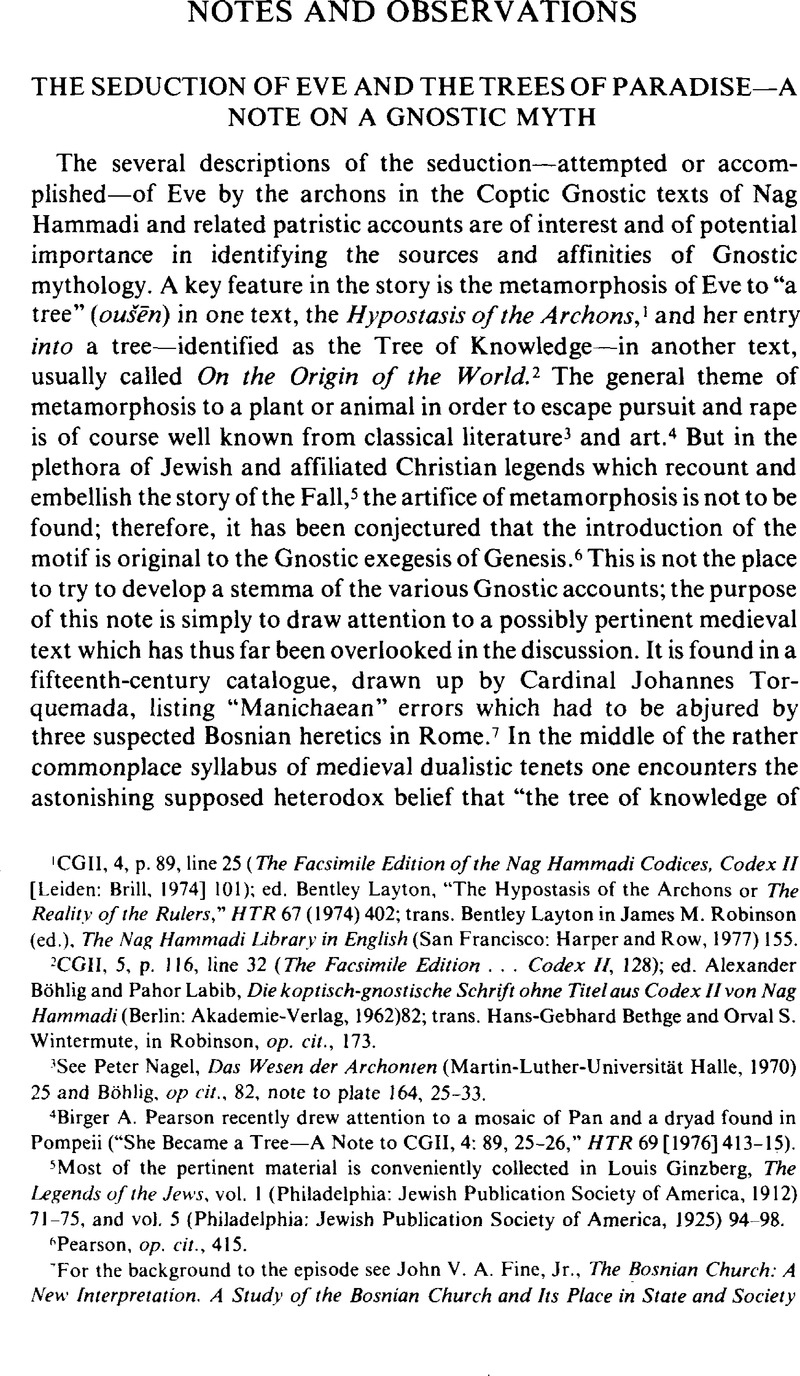Published online by Cambridge University Press: 10 June 2011

1 CGII, 4, p. 89, line 25 (The Facsimile Edition of the Nag Hammadi Codices, Codex II [Leiden: Brill, 1974] 101)Google Scholar; ed. Layton, Bentley, “The Hypostasis of the Archons or The Reality of the Rulers,” HTR 67 (1974) 402Google Scholar; trans. Layton, Bentley in Robinson, James M. (ed.). The Nag Hammadi Library in English (San Francisco: Harper and Row, 1977) 155Google Scholar.
2 CGII, 5, p. 116, line 32 (The Facsimile Edition … Codex II, 128); ed. Böhlig, Alexander and Labib, Pahor, Die koptisch-gnostische Schrift ohne Titelaus Codex II von Nag Hammadi (Berlin: Akademie-Verlag, 1962) 82Google Scholar; trans. Hans-Gebhard Bethge and Orval S. Wintermute, in Robinson, op. cit., 173.
3 See Nagel, Peter, Das Wesen der Archomen (Martin-Luther-Universitat Halle, 1970) 25Google Scholar and Böhlig, op cit., 82, note to plate 164, 25–33.
4 Birger A. Pearson recently drew attention to a mosaic of Pan and a dryad found in Pompeii (“She Became a Tree—A Note to CGII, 4: 89, 25–26,” HTR 69 [1976] 413–15)CrossRefGoogle Scholar.
5 Most of the pertinent material is conveniently collected in Ginzberg, Louis, The Legends of the Jews, vol. 1 (Philadelphia: Jewish Publication Society of America, 1912) 71–75Google Scholar, and vol. 5 (Philadelphia: Jewish Publication Society of America, 1925) 94–98.
6 Pearson, op. cit., 415.
7 For the background to the episode see Fine, John V. A.Jr.., The Bosnian Church: A New Interpretation. A Study of the Bosnian Church and Its Place in State and Society from the 13th to the 15th Centuries (East European Monographs, No. X, East European Quarterly, Boulder, distr. by Columbia University Press, New York and London, 1975) 335–38Google Scholar; see also Loos, Milan, Dualist Heresy in the Middle Ages (Prague: Academia, 1974) 319–20Google Scholar.
8 Lignum scientie boni et mal fuisse mulierem et quod Adam cognouit earn et propter hoc expulsis fuerit de paradiso (ed. Kniewald, Dragutin, Vjerodoslojnost latinskih izvora o bosanskim krstjanima [Zagreb: Jugoslavenska Akademija Znanosti i Umjetnosti, 1949] 68, no. 12Google Scholar); for a translation see Fine, op. cit., 355.
9 So Fine, op. cit., 337.
10 The reader may wonder what mode of coitus can possibly be envisaged. A pertinent parallel is the story of Dionysus and Prosymnus as told by Clement of Alexandria in the Protrepticus (11.34.2–5). The god promised his sexual favors to one Prosymnus as the repayment of a debt; Prosymnus dies and Dionysus, to fulfill the promise, cuts a branch from the fig tree at the tomb, carves it in the shape of the membrum virile, and “sits upon the branch, fulfilling the promise to the dead person” (ἐφέζεταί τε τῷ κλάδῳ, τὴν ὑπóσχεσιν ἐκτελῶν τῷ νεκρῷ). (Ed. Treu, Otto Stählin-Ursula, Clemens Alexandrinus, Erster Band [Berlin: Akademie Verlag, 1972] 26, lines 4–5Google Scholar). Mutatis mutandis, the “cognouit earn” of our text may refer to such a technique. Alternatively, if the Tree of Knowledge is taken to be a fig tree (see Ginzberg, Legends, vol. 5, 97 and Leder, Hans-Günter, “Arbor Scientiae: Die Tradition vom paradiesischen Apfelbaum,” ZNW 52 [1961] 164–67Google Scholar), the use of “fig,” sykon, for the female pudenda, perhaps more widespread than the solitary reference to Aristophanes in Liddell-Scott-Jones would indicate, may provide a clue to the sexual imagery.
11 Pertinent material is collected by Tardieu, Michel, Trois mythes gnostiques. Adam, Eros et les animaux d'Egypte dans un écrit de Nag Hammadi (II, 5) (Paris: Etudes augustiniennes, 1974) 165–74Google Scholar.
12 See Ginsberg, Legends, vol. 5, 133, note 3.
13 In view of the mention of the Tree of Knowledge in our text as well as in the Coptic On the Origin of the World, the conjecture that originally the tree mentioned in the Hypostasis of the Archons was the Tree of Life, because of the Aramaic wordplay ḥayyayā-Ḥawwāh (Layton, Bentley, “The Hypostasis of the Archons [Conclusion],” HTR 69 [1976] 57CrossRefGoogle Scholar) lacks cogency, to my mind. The personification of the Tree of Knowledge (a participant, so to speak, in the drama) is seemingly the more primitive concept.